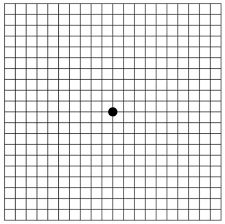A common question for many is whether or not there is a macular degeneration test that can help diagnose age related macular degeneration in its early stages.
While it is important to get regular eye exams performed by your eye care professional, there is a simple free macular degeneration test that can be performed in the comfort of your own home.
The Amsler Grid or sometimes referred to as an Amsler Chart is a visual tool that helps detect macular degeneration or damage to the optic nerve. It is believed to have been introduced by Swiss Ophthalmologist, Marc Amsler in 1947.
When looking at the Amsler Grid, an individual suffering from macular disease may see wavy lines on the grid. See image below.

If you have been diagnosed with macular degeneration, it is recommended to test your eyes with an Amsler Grid daily. This is the best way to monitor any changes in your eyesight or advancements in the disease.
If you are suffering from macular degeneration, using this home test is an easy way to monitor your vision, but shouldn’t replace regular visits to your eye doctor.
If you experience any of the following:
Then schedule an eye exam immediately.
According to the US National Library of Medicine National Institutes of Health, “Early detection of the onset or progression of macular disease is likely to become increasingly important as new treatment modalities are introduced. Current best practice involves issuing patients with an Amsler chart for daily or weekly observation with the instruction to attend for immediate assessment should any new distortion be perceived.”
Macular degeneration is the leading cause of blindness in individuals over the age of 50. It stems from the deterioration of a central part of the eye called the macula as a result of deposits called drusen. This area of the eye is need for central vision and as the macula begins to deteriorate one can experience a black spot in the center of their visual field.
While macular degeneration is most common in men and women over the age of 60, it can occur at younger ages.
There are several factors that can contribute to your chances of developing age relate macular degeneration. Some of these factors are:
It has been determined that lifestyle can also affect your chances of developing AMD and it is important to always maintain normal blood pressure and cholesterol levels, not smoke, get plenty of exercise, and eat a diet rich in green leafy vegetables and fish.
This is what the NIH Website says about other Macular Degeneration Tests:
“The early and intermediate stages of AMD usually start without symptoms. Only a comprehensive dilated eye exam can detect AMD. The eye exam may include the following:
Visual acuity test. This eye chart measures how well you see at distances.
Dilated eye exam. Your eye care professional places drops in your eyes to widen or dilate the pupils. This provides a better view of the back of your eye. Using a special magnifying lens, he or she then looks at your retina and optic nerve for signs of AMD and other eye problems.
Fluorescein angiogram. In this test, which is performed by an ophthalmologist, a fluorescent dye is injected into your arm. Pictures are taken as the dye passes through the blood vessels in your eye. This makes it possible to see leaking blood vessels, which occur in a severe, rapidly progressive type of AMD (see below). In rare cases, complications to the injection can arise, from nausea to more severe allergic reactions.
Optical coherence tomography. You have probably heard of ultrasound, which uses sound waves to capture images of living tissues. OCT is similar except that it uses light waves, and can achieve very high-resolution images of any tissues that can be penetrated by light—such as the eyes. After your eyes are dilated, you’ll be asked to place your head on a chin rest and hold still for several seconds while the images are obtained. The light beam is painless.”
The cases of macular degeneration worldwide are growing quickly as the baby boomers age. It is crucial to have your eyes examined routinely, especially if you are at higher risk of macular degeneration due to lifestyle or hereditary reasons.
If you have been diagnosed with macular degeneration the Amsler Grid can be a great way to monitor your vision on a daily basis in between scheduled eye exams. If you experience changes in your vision, see blurry or wavy lines when looking at the Amsler Grid it is important to see a doctor immediately for a professional macular degeneration test.
We have included a link here to a free Amsler Grid that you can save and print off to use in the comfort of your home.